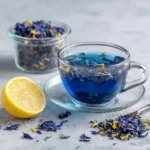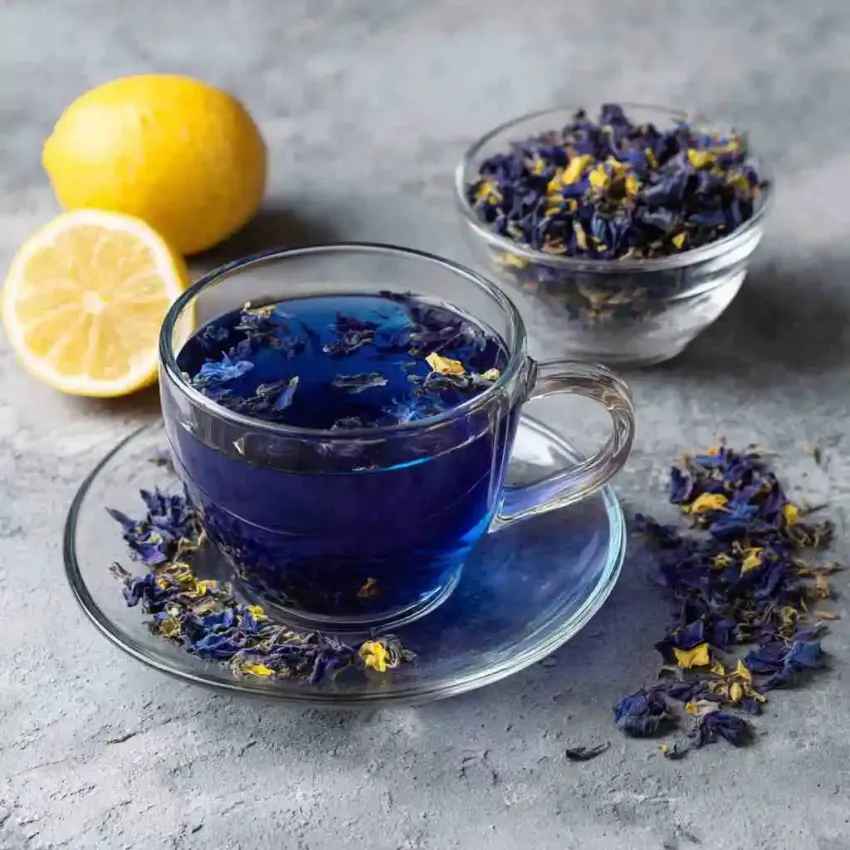Bright blue in color and steeped in Southeast Asian tradition, butterfly pea flower tea isn’t just pretty—it’s powerful. This guide explores everything you need to know about butterfly pea flower tea: from my first encounter with this magical brew to its health benefits, brewing techniques, potential side effects, and its legal status. Whether you’re sipping it for wellness or wow factor, this tea deserves a place in your kitchen.
Table of Contents

Butterfly Pea Flower Tea Benefits: Natural Color, Real Wellness
- Total Time: 10 minutes
- Yield: 1 servings 1x
- Diet: Vegan
Description
Butterfly pea flower tea is a vibrant, antioxidant-rich herbal drink that changes color with citrus. Enjoy it hot or iced for a refreshing, caffeine-free treat.
Ingredients
1 tsp dried butterfly pea flowers or 1 tea bag
1 cup boiling water
1 tsp honey or sweetener of choice (optional)
Juice of ½ lemon or lime (optional)
Instructions
Boil water in a kettle or saucepan.
Add butterfly pea flowers or tea bag to a cup.
Pour hot water over the flowers and steep for 5–7 minutes.
Add lemon or lime juice if desired to change color to violet.
Sweeten with honey or another sweetener.
Serve hot or let cool and pour over ice for a cold version.
Notes
Adding citrus not only changes the color but also enhances flavor.
You can infuse with herbs like mint, lemongrass, or ginger for added taste.
Store any leftover tea in the fridge and consume within 2 days.
- Prep Time: 5 minutes
- Cook Time: 5 minutes
- Category: Drinks
- Method: Steeping
- Cuisine: Herbal
Nutrition
- Serving Size: 1 cup
- Calories: 5
- Sugar: 0g
- Sodium: 0mg
- Fat: 0g
- Saturated Fat: 0g
- Unsaturated Fat: 0g
- Trans Fat: 0g
- Carbohydrates: 1g
- Fiber: 0g
- Protein: 0g
- Cholesterol: 0mg
Keywords: butterfly pea flower tea, herbal tea, blue tea, color changing tea
My Journey Into Butterfly Pea Flower Tea
The first time I saw that electric blue brew
I first came across butterfly pea flower tea during a community potluck at the co-op where I work part-time. Someone brought a vivid blue drink with floating lime slices, and I honestly thought it was artificially colored punch. But then she told me it was natural—made from dried butterfly pea flowers. I had never heard of it, and that’s saying something for someone who’s tried everything from turmeric lattes to beet kvass.
Naturally, I had to try making it myself.
That night, I brewed a small pot. The flowers turned the hot water a rich, deep blue—like indigo ink. When I added lemon juice, it transformed into a purple hue right before my eyes. It was like science class and herbalism had a baby, and I was hooked.
How it fits into my self-taught cooking path
When I started cooking in my twenties, I was chasing memories—like the banana bread I used to bake with my mom. Over the years, I’ve learned that food is more than nostalgia. It’s discovery. Butterfly pea flower tea was one of those discoveries that reminded me cooking isn’t just about filling a plate—it’s about play, curiosity, and sometimes just brewing something beautiful because it makes you feel good.
What I love about this tea is that it’s caffeine-free and wildly flexible. You can brew it hot, iced, sweetened, or spiked with a splash of lime to watch it shift from deep blue to vibrant violet. It’s simple, fun, and incredibly photogenic. The beauty is only half the story—this little flower packs real wellness benefits, too.
Butterfly Pea Flower Tea Health Benefits
Antioxidants, heart health & blood sugar balance
Butterfly pea flower tea isn’t just visually striking—it’s backed by science for its health perks, too. The vibrant blue hue comes from anthocyanins, powerful antioxidants also found in berries and red cabbage. These compounds help your body fight oxidative stress, the process that contributes to aging, inflammation, and chronic diseases.
Some of the most impressive butterfly pea flower tea benefits come from its role in heart health. In animal studies, the flower’s extract has shown potential to lower blood pressure and improve circulation by relaxing blood vessels. It also appears to reduce fat buildup and improve lipid metabolism.
This tea may also be beneficial for managing blood sugar. A small human study showed that butterfly pea extract reduced insulin and glucose spikes after consuming sugar. That’s why many consider butterfly pea flower tea a promising herbal aid for those watching their sugar levels or dealing with insulin resistance. While tea is milder than extracts, sipping it regularly may still contribute to better metabolic balance.
Brain support & digestive perks
Traditional medicine has used butterfly pea flower for centuries to support memory and mood. Some early animal studies suggest the tea may help improve cognitive performance and potentially offer neuroprotective effects in cases of degenerative conditions like Alzheimer’s. While the research is still early, it’s one of the reasons butterfly pea flower has been used in Ayurvedic remedies for centuries.
And let’s not forget your gut. Anecdotally, this tea may help ease bloating and support smoother digestion. It’s caffeine-free, making it gentle on your stomach and ideal for evening sipping. Some even use it to settle mild nausea—just don’t overdo it, as too much of any herbal brew can be hard on your belly.
Whether you’re drinking it to boost your brain, balance blood sugar, or simply unwind, butterfly pea flower tea offers a natural, low-effort way to feel a little more in tune with your body.
How to Brew Butterfly Pea Flower Tea

Step-by-step recipe: hot & iced versions
Making butterfly pea flower tea is as easy as it is mesmerizing. Start with one cup of boiling water and add about one teaspoon of dried butterfly pea flowers—or just drop in a pre-portioned tea bag. Steep the flowers for five to seven minutes, or until the water turns a vivid, deep blue that’s almost hypnotic.
At this point, you can sweeten it with honey, or for a tangy twist and a bit of magic, squeeze in some lemon or lime juice. Adding citrus lowers the tea’s pH, triggering a natural reaction that shifts its color from bold blue to stunning violet. It’s a fun science experiment and tea moment rolled into one.
For iced tea, simply follow the same steps and let the tea cool. Then pour it over ice. You can also infuse it with a few fresh mint leaves or a splash of lemonade for extra refreshment. It’s a fantastic summer cooler that looks fancy but takes less than ten minutes to make.
This tea’s color-changing property makes it a favorite for brunch parties or kids’ science-themed treats. It’s fun, flexible, and takes almost no effort to make at home.
Tips on flavoring, color changes, and pairing
Butterfly pea flower tea is naturally earthy and mild, which makes it perfect for customizing. I love steeping it with lemongrass, ginger slices, or even a cinnamon stick for depth. A few crushed cardamom pods can bring a subtle warmth, while mint adds cooling notes. It plays well with floral or tropical flavors, so don’t be afraid to experiment.
It also pairs beautifully with coconut-based desserts or buttery shortbread cookies. I often brew a pot alongside another calming drink in the evenings—one for calm, one for comfort. And since this tea is naturally caffeine-free, it’s ideal for unwinding without any buzz.
Butterfly Pea Flower Tea Side Effects, Warnings & Legality
Who should avoid butterfly pea flower tea?
Butterfly pea flower tea is generally safe for most people, but there are a few important exceptions. If you’re pregnant or breastfeeding, it’s best to avoid this tea unless your healthcare provider says otherwise. Some traditional sources believe it may affect uterine muscles, but there’s currently not enough scientific evidence to guarantee it’s safe during pregnancy.
People managing low blood pressure or taking medication for hypertension should also use caution. The tea can have a natural vasorelaxing effect, which may amplify the effects of blood pressure medication. If you’re taking any cardiovascular drugs, talk to your doctor before adding this herbal tea to your daily habits.
And like with any herb-based infusion, moderation matters. Drinking more than a couple of strong cups a day could lead to minor discomfort such as nausea, bloating, or cramping. Most people tolerate butterfly pea flower tea well, and any side effects are usually minor and infrequent. If that happens, simply using fewer flowers or shortening the steep time often clears it up.
Side effects and U.S. legality
The good news? Butterfly pea flower is fully legal and widely available in the U.S. It’s considered safe by the FDA and is commonly used in drinks, desserts, and natural food coloring. You don’t need any special license to grow, sell, or sip it.
That said, make sure to buy food-grade petals. Some decorative versions may be treated with chemicals not intended for consumption. Stick to trusted sources that specialize in culinary herbs or certified tea blends.
So while this tea is beautiful and beneficial, it’s worth knowing your body and starting slow. A little mindfulness goes a long way toward enjoying it safely.
Frequently Asked Questions about Butterfly Pea Flower Tea
What does butterfly pea flower tea do for you?
Butterfly pea flower tea is packed with antioxidants, particularly anthocyanins, which support heart and brain health. Some studies suggest it may help reduce blood sugar spikes, support cognitive function, and provide mild anti-inflammatory and antimicrobial effects. It’s also caffeine-free, making it a great herbal option for relaxation.
Who should not drink butterfly pea tea?
Pregnant or breastfeeding individuals should avoid this tea unless approved by a healthcare provider, due to concerns about its effect on uterine muscles. People with low blood pressure or those on medication for hypertension should also be cautious, as the tea may enhance blood vessel relaxation and amplify medication effects.
What are the side effects of butterfly pea flower tea?
Most people don’t experience side effects, but drinking large amounts or overly strong brews may lead to mild issues like nausea, bloating, or stomach cramps. Reducing the steep time or quantity typically prevents discomfort. As with any herbal tea, moderation is key.
Is butterfly pea flower legal?
Yes, butterfly pea flower is completely legal in the United States. It’s approved for use as a food and beverage ingredient by the FDA and is often used in lattes, cocktails, teas, and natural food coloring. Just make sure to buy food-grade quality from a reputable source.
Conclusion
Butterfly pea flower tea might look like something from a fairytale, but its benefits are very real. From its antioxidant power to its natural color-changing magic, it’s a drink that brings wellness, beauty, and curiosity into every cup. For me, it started as a visual surprise at a community potluck—but it quickly became part of my regular routine, especially when I want something caffeine-free and calming.
Whether you’re brewing it hot on a rainy evening or pouring it over ice on a sunny porch, butterfly pea flower tea is an easy way to connect with something simple, colorful, and nourishing. Like most things in the kitchen, it’s about discovering what makes you feel good—one sip at a time.
Ready to make your own? Scroll down for the full recipe and try it out today.
For more recipes follow me in Facebook
Frequently Asked Questions about Butterfly Pea Flower Tea
What does butterfly pea flower tea do for you?
Butterfly pea flower tea is packed with antioxidants, particularly anthocyanins, which support heart and brain health. Some studies suggest it may help reduce blood sugar spikes, support cognitive function, and provide mild anti-inflammatory and antimicrobial effects. It’s also caffeine-free, making it a great herbal option for relaxation.
Who should not drink butterfly pea tea?
Pregnant or breastfeeding individuals should avoid this tea unless approved by a healthcare provider, due to concerns about its effect on uterine muscles. People with low blood pressure or those on medication for hypertension should also be cautious, as the tea may enhance blood vessel relaxation and amplify medication effects.
What are the side effects of butterfly pea flower tea?
Most people don’t experience side effects, but drinking large amounts or overly strong brews may lead to mild issues like nausea, bloating, or stomach cramps. Reducing the steep time or quantity typically prevents discomfort. As with any herbal tea, moderation is key.
Is butterfly pea flower legal?
Yes, butterfly pea flower is completely legal in the United States. It’s approved for use as a food and beverage ingredient by the FDA and is often used in lattes, cocktails, teas, and natural food coloring. Just make sure to buy food-grade quality from a reputable source.
Drinks of The Same Type
